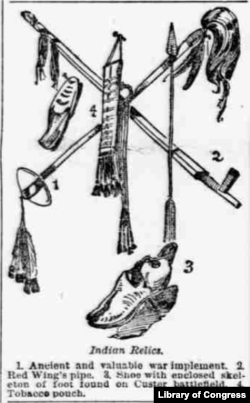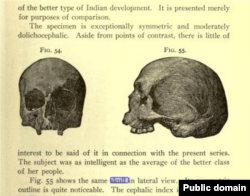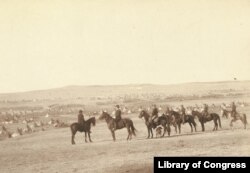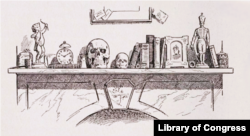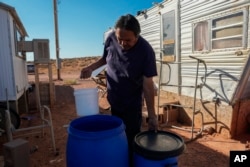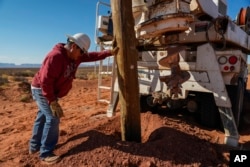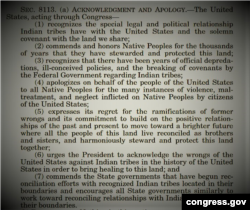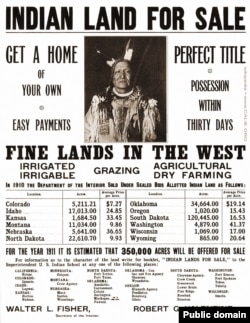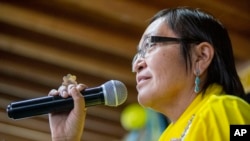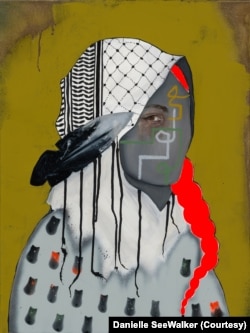Native Americans
What happened to Native American skull looted by Chicago reporter?
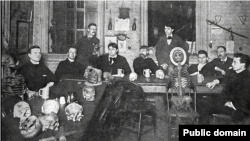
NOTE: This story contains culturally sensitive information that may be distressing for some readers. Caution is advised.
WASHINGTON — In the summer of 1889, a group of cynical Chicago crime reporters organized itself as the Whitechapel Club, taking the name of the London district where serial killer Jack the Ripper found his victims.
They rented rooms in a back-alley saloon, and in keeping with the club’s macabre theme, they decorated the walls with relics of war and crimes: revolvers, knives, hangman’s ropes.
“I suppose the gruesome [sic] connotations of the name led to our practice of collecting relics of the tragedies we were constantly reporting,” member Brand Whitlock recalled in his 1914 memoir, “Forty Years of It.”
John C. Spray, the former superintendent of the county’s mental asylum, donated skulls which Whitechapel member Chrysostom “Tomb” Thompson converted into tobacco jars, drinking cups and shades for gas lamps.
Whitechapel member and Chicago Herald writer Charles Goodyear Seymour was among the correspondents who covered the 1890 Wounded Knee massacre of as many as 300 Miniconjou and Hunkpapa Lakota men, women and children in South Dakota. He returned home with a collection of war relics, including a woman’s ghost shirt — white cotton, embroidered with yellow — and Native American skulls, according to Brand.
Seymour also traveled to the Blackfeet and Piegan reservation in Montana, recounted in a May 12, 1891, article for the Herald titled, “How to Steal a Skull.” Seymour described how he and an Army infantry lieutenant sneaked into a graveyard at night and managed to retrieve two skulls.
“There is not much fun in robbing a graveyard,” he wrote, “even if it is an Indian graveyard.”
'A large collection'
The Whitechapel Club’s reputation helped grow its ghastly collection.
“It became the practice of sheriffs and newspapermen everywhere to send anything of that kind to the Whitechapel Club. The result was that within a few years, it had a large collection of skulls of criminals,” Whitlock would later write.
Among Seymour’s contributions was the skull of an “Unc’papa [Hunkpapa Lakota]” woman, described by Whitechapel member George Frank Lydston as “the wife of one of the leading malcontents in the recent outbreak” at Wounded Knee.
Lydston was a Chicago urologist and professor of criminal anthropology at the Chicago-Kent College of Law. He was also a staunch eugenicist who believed that the shape of people’s skulls indicated intelligence or “undesirable” traits such as criminality and other forms of “degeneracy.” Lydston, who was a member of the Whitechapel Club, used some of the skulls to support his research.
The Wounded Knee skull was among several that Lydston presented in a 1904 book, “The Diseases of Society: The Vice and Crime Problem.”
He concluded little about the Hunkpapa skull, other than that she had an elongated and symmetrical head and was likely “as intelligent as the average of the better class of her people.”
So, who was she and what happened to her skull? Did she really die in the massacre, or had Seymour invented her identity to add to the skull’s grisly appeal?
Shortly before his death in 1920, Joseph Horn Cloud, a Miniconjou Lakota Wounded Knee survivor who later co-founded the Wounded Knee Survivors Association, compiled a list of individuals who survived or were killed in the massacre.
In 2019, the Cheyenne River Sioux Tribe's West River Eagle published a separate list, date unknown.
Most were Miniconjou followers of Spotted Elk from the Cheyenne River Reservation or Hunkpapa followers of his half-brother Sitting Bull from the Standing Rock Reservation.
Comparing both lists, VOA was able to identify three Hunkpapa women who died in the massacre: Zintaikiwin (Bird’s Belly), Itewakanwin (Sacred Face), and Wannawega tawicu (Wife of Breaks Arrows with Foot). Two women died later of wounds received in the massacre: Wowacinyewin (Dependable) and Kicinajinwin (Wife of Stands With).
It is not known if their bodies were recovered by their families or buried in the mass grave at Wounded Knee.
From Chicago to Washington
In May 1891, Lydston traveled to Washington to present his findings at the annual convention of the American Medical Association. He brought with him a trunk full of skulls, The Washington Post reported, including that of the Hunkpapa woman.
Lydston boasted that it was he, not Seymour, who had been sent to Wounded Knee and retrieved the skull, adding that while he was there, he had been taken prisoner and held for more than three weeks. He did not say by whom.
“He was allowed just enough to live on, and was a walking skeleton when released,” the Post reported.
Lydston told the newspaper he was donating the skulls to AMA.
“Dr. Lydston says the club did not want to give up these specimens, but he persuaded the members into doing so,” the Post concluded. “He says that no amount of money would buy the specimens now in the hall of the Whitechapel Club.”
VOA reached out to AMA about the Hunkpapa skull.
“Based on a review of AMA’s archives, the AMA neither currently nor in the past possessed human tissue or specimens,” a spokesperson responded via email. “In official proceedings, there are mentions of exhibits that contained human remains, but these were presented at meetings and then went on tour or home with the exhibitor.”
The AMA says one of those exhibits at its Chicago headquarters was dismantled in 1935 and its contents donated to the city’s Museum of Science and Industry.
Kathleen McCarthy, head curator at the Chicago Museum of Science and Industry, told VOA, “We have no record of a donation of skulls from the American Medical Association in 1935. In all my time here, I have not heard of or seen any skulls in the collection.”
What if Lydston did not donate the Whitechapel Club skulls as he claims and kept them for himself?
After the club dissolved in 1895, Lydston published “Over the Hookah: The Tales of a Talkative Doctor” in which an aging “Dr. Weymouth” relates a series of anecdotes to a young medical student.
Though it is a work of fiction, Lydston acknowledges in the preface that the tales are “taken from life.”
In one chapter, the student describes a large cabinet in the older doctor’s library. It contains a collection of “curious and ghastly skulls” that were “the doctor’s pride.”
Lydston died of pneumonia in 1923. In his last will and testament, he left all property to his wife. But there is no record of the contents of that property.
The 1990 Native American Graves and Repatriation Act, NAGPRA, requires museums and federal agencies to take an inventory of all human remains and funerary objects in their collection and work with tribes to return them. Updated rules give them until 2029 to comply.
“The law is very clear that institutions do not own native bodies or cultural items unless they can prove a right of possession,” said Shannon O’Loughlin, a citizen of the Choctaw Nation of Oklahoma and CEO and attorney for the Association on American Indian Affairs. “That means that there had to have been voluntary consent at the time of taking of the Native ancestor or other cultural items.”
Nor did Congress provide a remedy for cases in which private collectors or non-federally funded organizations hold Native American remains and related artifacts.
If the Lydston family donated the Hunkpapa skull to a medical school or other public institution covered by the law, she may one day be returned to her lineal descendants and the Hunkpapa community.
See all News Updates of the Day
US forest managers finalize land exchange with Native American tribe in Arizona
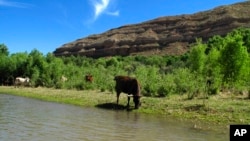
U.S. forest managers have finalized a land exchange with the Yavapai-Apache Nation that has been decades in the making and will significantly expand the size of the tribe's reservation in Arizona's Verde Valley, tribal leaders announced Tuesday.
As part of the arrangement, six parcels of private land acquired over the years by the tribe will be traded to the U.S. Forest Service in exchange for the tribe gaining ownership of 12.95 square kilometers of national forest land that is part of the tribe’s ancestral homelands. The tribe will host a signing ceremony next week to celebrate the exchange, which was first proposed in 1996.
“This is a critical step in our history and vital to the nation’s cultural and economic recovery and future prosperity,” Yavapai-Apache Chairwoman Tanya Lewis said in a post on the tribe's website.
Prescott National Forest Supervisor Sarah Clawson said in a statement that there had been many delays and changes to the proposal over the years, but the tribe and the Forest Service never lost sight of developing an agreement that would benefit both public and tribal lands.
The federal government has made strides over recent years to protect more lands held sacred by Native American tribes, to develop more arrangements for incorporating Indigenous knowledge into management of public lands and to streamline regulations for putting land into trust for tribes.
The Yavapai-Apache Nation is made up of two distinct groups of people — the Wipuhk’a’bah and the Dil’zhe’e. Their homelands spanned more than 41,440 square kilometers of what is now central Arizona. After the discovery of gold in the 1860s near Prescott, the federal government carved out only a fraction to establish a reservation. The inhabitants eventually were forced from the land, and it wasn't until the early 1900s that they were able to resettle a tiny portion of the area.
In the Verde Valley, the Yavapai-Apache Nation's reservation lands are currently comprised of less than 7.77 square kilometers near Camp Verde. The small land base hasn't been enough to develop economic opportunities or to meet housing needs, Lewis said, pointing to dozens of families who are on a waiting list for new homes.
Lewis said that in acknowledgment of the past removal of the Yavapai-Apache people from their homelands, the preamble to the tribal constitution recognizes that land acquisition is among the Yavapai-Apache Nation's responsibilities.
Aside from growing the reservation, the exchange will bolster efforts by federal land managers to protect the headwaters of the Verde River and ensure the historic Yavapai Ranch is not sold for development. The agreement also will improve recreational access to portions of four national forests in Arizona.
On Navajo Nation, push to electrify more homes on vast reservation
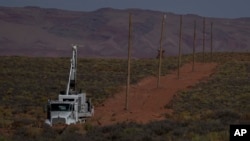
After a five-year wait, Lorraine Black and Ricky Gillis heard the rumblings of an electrical crew reach their home on the sprawling Navajo Nation.
In five days' time, their home would be connected to the power grid, replacing their reliance on a few solar panels and propane lanterns. No longer would the CPAP machine Gillis uses for sleep apnea or his home heart monitor transmitting information to doctors 400 miles away face interruptions due to intermittent power. It also means Black and Gillis can now use more than a few appliances — such as a fridge, a TV, and an evaporative cooling unit — at the same time.
"We're one of the luckiest people who get to get electric," Gillis said.
Many Navajo families still live without running water and electricity, a product of historic neglect and the struggle to get services to far-flung homes on the 70,000-square-kilometer (27,000-square-mile) Native American reservation that lies in parts of Arizona, New Mexico and Utah. Some rely on solar panels or generators, which can be patchy, and others have no electricity whatsoever.
Gillis and Black filed an application to connect their home back in 2019. But when the coronavirus pandemic started ravaging the tribe and everything besides essential services was shut down on the reservation, it further stalled the process.
Their wait highlights the persistent challenges in electrifying every Navajo home, even with recent injections of federal money for tribal infrastructure and services and as extreme heat in the Southwest intensified by climate change adds to the urgency.
"We are a part of America that a lot of the time feels kind of left out," said Vircynthia Charley, district manager at the Navajo Tribal Utility Authority, a non-for-profit utility that provides electric, water, wastewater, natural gas and solar energy services.
For years, the Navajo Tribal Utility Authority has worked to get more Navajo homes connected to the grid faster. Under a program called Light Up Navajo, which uses a mix of private and public funding, outside utilities from across the U.S. send electric crews to help connect homes and extend power lines.
But installing power on the reservation roughly the size of West Virginia is time-consuming and expensive due to its rugged geography and the vast distances between homes. Drilling for power poles there can take several hours because of underground rock deposits while some homes near Monument Valley must have power lines installed underground to meet strict regulations around development in the area.
About 32% of Navajo homes still have no electricity. Connecting the remaining 10,400 homes on the reservation would cost $416 million, said Deenise Becenti, government and public affairs manager at the utility.
This year, Light Up Navajo connected 170 more families to the grid. Since the program started in 2019, 882 Navajo families have had their homes electrified. If the program stays funded, Becenti said it could take another 26 years to connect every home on the reservation.
Those that get connected immediately reap the benefits.
Until this month, Black and Gillis' solar panels that the utility installed a few years ago would last about two to three days before their battery drained in cloudy weather. It would take another two days to recharge.
"You had to really watch the watts and whatever you're using on a cloudy day," Gillis said.
Then a volunteer power crew from Colorado helped install 14 power poles while the tribal utility authority drilled holes six feet deep in which the poles would sit. The crew then ran a wire about a mile down a red sand road from the main power line to the couple's home.
"The lights are brighter," Black remarked after her home was connected.
In recent years, significantly more federal money has been allocated for tribes to improve infrastructure on reservations, including $32 billion from the American Rescue Plan Act of 2021 — of which Navajo Nation received $112 million for electric connections. The Navajo tribal utility also received $17 million through the Biden administration's climate law, known as the Inflation Reduction Act, to connect families to the electric grid. But it can be slow to see the effects of that money on the ground due to bureaucracy and logistics.
Next spring, the tribal utility authority hopes to connect another 150 homes, including the home of Priscilla and Leo Dan.
For the couple, having grid electricity at their home near Navajo Mountain in Arizona would end a nearly 12-year wait. They currently live in a recreational vehicle elsewhere closer to their jobs but have worked on their home on the reservation for years. With power there, they could spend more time where Priscilla grew up and where her dad still lives.
It would make life simpler, Priscilla said. "Because otherwise, everything, it seems like, takes twice as long to do."
Native Americans react to Biden apology as a good ‘first step’
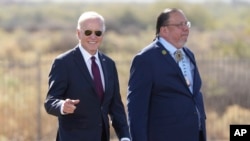
President Joe Biden visited the Gila River Indian Community in Arizona on Friday to deliver a long-awaited official apology to Native Americans for the federal boarding school system that severed the family, tribal and cultural ties of thousands of Indian children over multiple generations.
“I say this with all sincerity: This, to me, is one the most consequential things I've ever had an opportunity to do in my whole career as president of the United States,” Biden said.
He described how Native children were “stolen, taken away to places they didn't know by people they'd never met who spoke a language they had never heard,” he said.
“Children would arrive at school, their clothes taken off, their hair that they were told [was] sacred was chopped off, their names literally erased and replaced by a number or an English name,” he continued, “emotionally, physically and sexually abused, forced into hard labor, some put up for adoption without the consent of their birth parents, some left for dead in unmarked graves.”
When the time came to apologize, Biden shouted the words, “I formally apologize!”
Mixed reactions
In 2021, Interior Secretary Deb Haaland launched an investigation into federal and federally funded Indian boarding schools. The investigation confirmed that more than 18,600 Native American, Native Alaskan and Native Hawaiian children were forced to attend residential schools; 1,000 died during their enrollment.
The report recommended the U.S. government formally acknowledge and apologize for its role in the system and take steps to help survivors heal from its effects.
VOA spoke with Christine Diindiisi McCleave, a citizen of the Turtle Mountain Band of Chippewa Indians in North Dakota and former CEO of the National Native American Boarding School Healing Coalition (NABS), which collaborated with the Interior investigation.
“I think politically it is extremely significant that Biden traveled to tribal lands in Gila River to deliver the apology publicly, not bury it in a defense appropriations bill,” she said, referencing a 2009 defense spending bill that acknowledged “years of official depredations, ill-conceived policies and the breaking of covenants” and apologized for instances of “violence, maltreatment and neglect.”
“However, as a survivor, as somebody who worked for many years to make progress on this issue, yes, we need the acknowledgment, but we also need actions to follow that up,” she said.
Friday’s apology came late in Biden’s term. McCleave said she worried that a Republican win in the November 5 presidential vote could reverse the gains for tribes made during the Biden-Harris administration.
“I hope they pass the Truth and Healing Commission bill before the new term begins,” she said.
The bipartisan Truth and Healing Commission on Indian Boarding School Policies Act, currently making its way through Congress, would create a commission to investigate the boarding school system and recommend action to promote healing.
Schools only part of the story
On Friday, Biden summarized his investments in Indian Country, which include $32 billion from the American Rescue Plan, $13 billion to support improvements in tribal infrastructure and $700 million from the Inflation Reduction Act to combat the effects of climate change.
He did not, however, address growing calls from Native communities for the return of historic lands, a campaign dubbed “Land Back.”
Brenda J. Child, a citizen of the Red Lake Band of Chippewa in Minnesota, is a professor of American studies at the University of Minnesota who has written extensively about Indian boarding schools from the perspective of Indigenous Americans.
“Boarding schools were about dispossessing Indian people of their lands,” she said, “which went hand in hand with the complex policy called the General Allotment Act of 1887, which helped break up the traditional systems of land tenure.”
Also known as the Dawes Act, it divided Native Americans’ communal tribal lands into individual plots that were doled out to families and individuals. The leftover land – about 36 million hectares (90 million acres) – was opened up for sale to non-Native settlers, passing out of Indian control.
“So, what do we do now?” Child asked. “Apologies are nice, but if you don't change the behavior, we're still stuck. Now it's time to return some of that land that we lost.”
Watch Biden’s entire speech below:
One of the last Navajo Code Talkers from World War II dies at 107
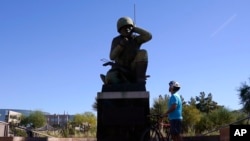
John Kinsel Sr., one of the last remaining Navajo Code Talkers who transmitted messages during World War II based on the tribe's native language, has died. He was 107.
Navajo Nation officials in Window Rock announced Kinsel's death on Saturday.
Tribal President Buu Nygren has ordered all flags on the reservation to be flown at half-staff until Oct. 27 at sunset to honor Kinsel.
"Mr. Kinsel was a Marine who bravely and selflessly fought for all of us in the most terrifying circumstances with the greatest responsibility as a Navajo Code Talker," Nygren said in a statement Sunday.
With Kinsel's death, only two original Navajo Code Talkers are still alive: Former Navajo Chairman Peter MacDonald and Thomas H. Begay.
Hundreds of Navajos were recruited by the Marines to serve as Code Talkers during the war, transmitting messages based on their then-unwritten native language.
They confounded Japanese military cryptologists during World War II and participated in all assaults the Marines led in the Pacific from 1942 to 1945, including at Guadalcanal, Tarawa, Peleliu and Iwo Jima.
The Code Talkers sent thousands of messages without error on Japanese troop movements, battlefield tactics and other communications crucial to the war's ultimate outcome.
Kinsel was born in Cove, Arizona, and lived in the Navajo community of Lukachukai.
He enlisted in the Marines in 1942 and became an elite Code Talker, serving with the 9th Marine Regiment and the 3rd Marine Division during the Battle of Iwo Jima.
President Ronald Reagan established Navajo Code Talkers Day in 1982 and the Aug. 14 holiday honors all the tribes associated with the war effort.
The day is an Arizona state holiday and Navajo Nation holiday on the vast reservation that occupies portions of northeastern Arizona, northwestern New Mexico and southeastern Utah.
Native American news roundup Oct. 13 – 19, 2024
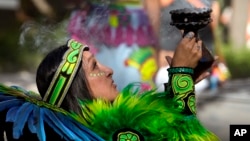
Indigenous Peoples Day and Columbus Day observed Monday
Some Americans this week celebrated Christopher Columbus’ October 1492 landing in the Western Hemisphere while others marked the alternative Indigenous Peoples’ Day commemorating the exploitation that began with Columbus’ arrival, which ultimately led to widespread displacement, violence, disease and enslavement.
The U.N. Committee on Non-Governmental Organizations in 1977 held the first International NGO Conference on Discrimination against Indigenous Populations in the Americas in Geneva. Attending delegates from Indigenous nations passed a resolution to recognize an “International Day of Solidarity with the Indigenous Peoples of the Americas.”
President Joe Biden in 2021 recognized Indigenous Peoples Day as a national — but not a federal — holiday. Today, more than two dozen states and many cities across the U.S. observe the day with powwows and other cultural events.
About 2,000 people gathered at the Getty Museum in Los Angeles to celebrate. VOA reporter Genia Dulot was there and filed this report:
Tribal protesters clash with police in nation’s capital
In Washington, D.C., the Indigenous People’s Day holiday brought confrontation between U.S. Park Police and protesters from the Muwekma Ohlone Tribe of California, who rode across the country on horseback along a "Trail of Truth" to lobby for federal recognition that the Interior Department's Bureau of Indian Affairs (BIA) denied decades ago.
The tribe claims descent from the Verona Band of Alameda County, which inhabited the San Francisco Bay Area for over 10,000 years.
In 1989 they petitioned the BIA for federal acknowledgment as the “Ohlone/Costanoan Muwekma Tribe.” The BIA rejected their application, citing a lack of evidence showing the tribe had continuously operated since 1927 as the same or an evolved tribal entity previously acknowledged.
Protests involving 25 or more people on the National Mall or other National Park Service (NPS)-controlled areas require a permit, which the group had not obtained. Tensions escalated when police attempted to remove the group and their horses.
"The Department of the Interior's posture with Native peoples is on full display," the group posted onFacebook. "Was Indian Country naive to think that Indigenous leadership at the top was going to change the institutional culture, colonial legal architecture, and systems of oppression that have always been the core function of the Department?"
In a statement to VOA, the NPS said the group has since dismantled their camp and submitted a permit application, which is under review.
"However, enforcement actions were taken, including the arrest of one person on October 16 for assaulting a police officer and other violations. On October 15, USPP officers arrested nine others for similar offenses," the statement said.
Minnesota tribe is latest to sue social media companies
CBS News reports this week that the Fond du Lac Band of Lake Superior Chippewa in Minnesota has joined four other tribes in a lawsuit against social media giants including Instagram, Snapchat, TikTok and YouTube for allegedly harming a Native American youth's mental health.
The 164-page complaint alleges that parent companies including Alphabet, ByteDance, Meta and Snap violated Minnesota laws by failing to warn users about the negative mental health effects of social media, particularly for children.
“They [Native teenagers] are more vulnerable because they've struggled with mental health because of isolation and poverty on some of the reservations,” attorney Tim Purdon, a partner in the law firm that filed the complaint, said during an interview in late July. “We seek dollars from them to be paid in our case directly to tribes to help abate or blunt or help fix the public mental health crisis that has resulted.”
Read more:
Navajo president calls for VP to resign
Navajo Nation president Buu Nygren has stripped Navajo vice president Richelle Montoya of her responsibilities and is calling for her resignation.
The announcement follows months of political tension within the tribe. In April, Montoya publicly accused the administration of intimidation and sexual harassment that she alleges took place during an August 2023 meeting in the president's office.
This prompted the tribal attorney to call for an independent investigation, which is still under way.
Nygren defended his actions in a news conference Tuesday, accusing the vice president of neglecting her official duties. He also cited Montoya’s decision to support a campaign to recall him as tribal leader.
“I welcome her resignation to make room for someone who wants to be a part of this administration,” Nygren said.
The rift between Nygren and Montoya has caused significant political upheaval, with tribal leaders and community members divided over the issues, further complicating governance and stability within the Navajo Nation.
Read more:
Lakota artist cites free speech rights, sues Colorado town
Danielle SeeWalker, a Hunkpapa Lakota artist from the Standing Rock Sioux Tribe, is suing the town of Vail, Colorado, after her artist residency was canceled.
As VOA reported in May, SeeWalker posted a painting titled “G is for Genocide” on Instagram. It showed a near-faceless woman wearing a feather and a keffiyeh, the traditional Bedouin headscarf that has become the symbol for solidarity with Palestinians.
“It is about me expressing the parallels between what is happening to the innocent people in Gaza ... to that of the genocide of Native American populations here in our lands,” SeeWalker wrote in her post.
The town of Vail said in a May Facebook post that its decision to cancel her residency “was not made in a vacuum; after releasing her name in an announcement, community members, including representatives from our local faith-based communities, raised concerns to town staff around SeeWalker's recent rhetoric on her social media platform about the Hamas-Israel war.”
Backed by the American Civil Liberties Union, SeeWalker claims her First Amendment rights were violated and is seeking damages.
Read more:




